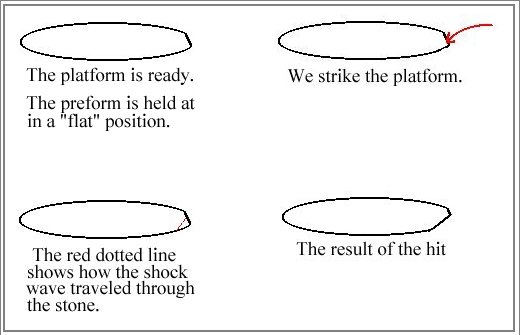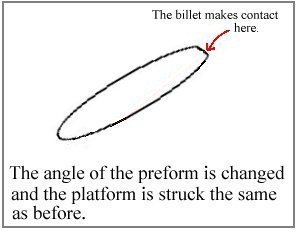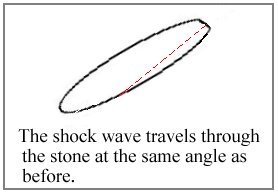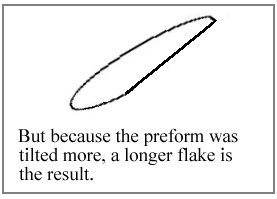© copyright 1998 by W.R. Knapp
Okay...by now you've learned about herzian cones. You know it's a cone shaped shock wave with sides that expand outward 130° to the point of impact on the stone. You know we use this shock wave, created from a billet strike, to make flakes come off knappable stone. But now we need to learn how to "cheat the angles" in order to make the best use of this shock wave.
After much practice you've probably standardized your billet swing so it's coming down at pretty much the same angle all the time. This swing has become natural to you. You're hitting your platforms pretty much the same every time. Since this swing has become a constant, we now have an opportunity to have some control over the thinning process and the length of the flakes we take off.
If you tilt your preform at different angles you can control how long your flakes are and how much material you remove. Depending on how much material you are trying to get through you may have to adjust the power of your strike as well. But a lot can be accomplished by understanding how to use different angles. The illustration below depicts a preform as viewed from the base end. The angle of the strike is indicated by the red arrow. Let's see how the shock wave travels through a stone that's held at this "flat " angle.

Well, the flake came off. And as you can see, we ended up with a rather shallow result. If we continue hitting our platforms with the preform held at this angle, it will get smaller and stay thick. We will get points that look like "turtle backs." This won't do, will it? Well, let's change the angle we hold the preform at and see what happens.
In the illustrations below we take the same preform we had before and start over. The angle of the strike is exactly the same as before. The resulting shock wave is at exactly the same angle as in the first example as well. The only thing different is, this time we're going to change the angle at which the preform is being held. Let's see what happens.



There we go! Now we took a nice bite out of it and got a flake that went right across the middle. If we keep this up the point will get thinner way faster than it gets narrow. By changing the angle at which we hold the preform, we can control how thick and long the flake is that we take off. Just don't hold it at too much of an angle or you'll get a hinge, or worse--you'll break the preform in half !
I should mention that the angles we showed in the illustrations are just examples. They might work for you. They might not. It depends on the angle of your billet swing. Experiment with the way you hold your preforms. Find what angles work for you and then all you have to do is practice enough to remember them.
Judicious use of this idea can really help you to "take the cap" off those really chunky pieces.
Good Luck !!
Back to the Flintknapping section
This page was last updated on 07 March 2012.
Copyright © 1998 & 2012 by Wyatt R. Knapp
Learn about the atlatl and dart system & the physics behind this powerful weapon
The Mysterious Nazca Lines: How were these huge desert glyphs made? Ancient astronauts?
Victory! Outdoorsmen, primitive skills enthusiasts! Find out more here!
History & Primitive Technology Page
Flintknapping: Observations & hints, hafting glue, etc.
Buckskinning Skills: Making gunflints, ancient Firemaking techniques, etc.
Primitive and Traditional Skills Links.
